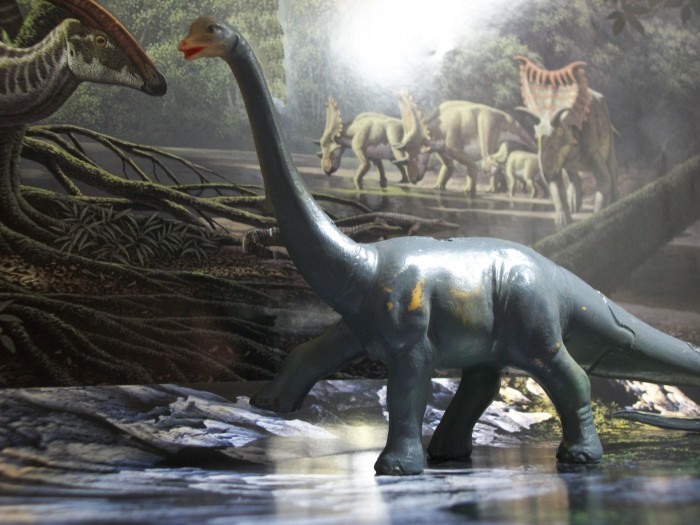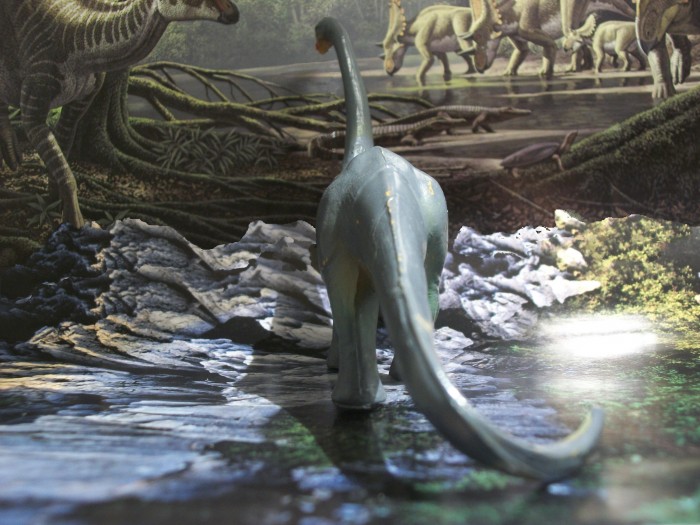
There are many wonderful paintings by Charles Knight, one in particular has a Apatosaurus in the fore-ground, with its head and neck rising out of the swampy water. It looks big and clumsy. In the back ground, grazing on the shore of this prehistoric swamp, there is a Diplodocus, painted in a boring grey color. Its head is down grazing on foliage, the skin has some elephantine wrinkles, and a graceful, rounded back. At the beginning of the 20th century, the scientific community had some interesting ideas on sauropods. They were considered clumsy, lumbering behemoths, that had to stay near or in the water to help support their immense weight. The Diplodocus being of a lighter build, was considered to be more agile than its contemporaries. Charles Knight echoed these ideas in his paintings. In 1907, he showed that it was light footed, by painting a Diplodocus rearing on its hind legs to eat from the top of some leaves by the waterfront.
Why do I reference the historical paintings of Charles Knight? The Starlux Diplodocus was designed in an active pose even though during the 1960’s or 70’s dinosaurs were still being depicted as slow, dumb, reptiles. Starlux depicted the Diplodocus in a “Classic” pose that is easy to identify, with smooth skin, a rounded back, with a tail dragging behind. It could have come right out of one of Knights paintings.

About the toy: As with Starlux toys, it is small, but slightly bigger than the Kaiyodo UHA toys. The pose is an active one, with the head is held up high on a erect neck, and one leg held high up in the air, as if it was marching in a parade. The head shape is very generic. The eyes are black, with nostrils located toward the end of the snout, and a red open mouth with no visible teeth. Half of the head is a orange-ish yellow, the rest is grey. The orange color seems to be the base color, as mine has a lot of grey paint that has rubbed off, and the orange is underneath.

The neck is smooth with no texture, and there is a visible seem line when it meets the torso. The seam line blends a little with some skin folds around the base of the neck. There are some skin folds on the body and on the legs. The legs have some nice muscle bulges and look good. There are four toes on each foot. You can see the seam where the tail and body meet up. The tail is short and curves down to the ground.

This is not a toy for small children. The plastic is very brittle, and even though the paint can be touched up easily, it does not handle rough play. Older children who know how to take care of their toys, could use them for play, but I think they are best used on display on the shelf or desk. Starlux toys are hard to find in North America, but there are some European web sites were you can still find them at reasonable prices. Scientifically, this Diplodocus is far from being accurate. I think its most attractive qualities are the “classic” look and a active pose that makes it look like it is on parade, or even prancing like a horse. If space is limited, it is rather small, so its easy to display. I think that this old Diplodocus could appeal to many new or old collectors.
Disclaimer: links to Ebay and Amazon on the DinoToyBlog are affiliate links, so we make a small commission if you use them. Thanks for supporting us!




Sorry but I strongly disagree with the analysis made on this review on the figure. It doesn’t represent a “Knightian” sauropod at all, but more of an Early Reinassance instead. That mentioned “dragging tail”, I can’t see anything like that. The tail is actually pretty obviosuly elevated, being only the tip which is touching the floor. The legs are straight and the belly is really far from the floor, like a mammal (compare this with the 2nd diplodocus version of starlux, or the invicta model). The raised “horse” leg again is nothing like any Charles Knight ever did, but it pretty much relates to Bob Bakker approach to Barosaurus and subsequent Reinassance depictions.
Thanks for the review, and hope you take this as a positive criticism and that the right to disagree on what you publish exists. I always enjoy the reviews and taking note they are just “toy reviews”, but… are they “just” that? We can’t deny this is a science-related site, and for that reason this is not the first time I wished you’d be a little more accurate on the “toy” analysis, because reviews like this could become desinformative and I’m pretty sure your intention is totally the opposite.
Thank you for your thoughts. I am not a paleontologist, but I do my best to be as accurate as possible. As for the analysis on the look of the model, I guess we can agree to disagree. When analyzing the look, my thoughts went to the 1907 Scientific American Diplodocus rearing up by Knight. Even in the 1897 Brontosaurus painting, the Diplodocus in the back ground is on land and looks more active than its sauropod brethren. Knight might have followed the idea that sauropods were slow and stupid, but he did paint Diplodocus a little lighter and active. In my opinion, if the tail was longer on this toy, it would have been just dragging along. As it is, the short tail heads down and it is on the ground. I am not saying its the worst tail dragger in history, but it just doesn’t look early renaissance to me. But I think we could agree that it does look like it belongs on a carousel,
Thanks to you too for your kind answer. I can see where you are pointing at. You see this diplo as he is about to rise on its hind legs, as in Knight’s painting.
Of course. That description of Osborn and Knight of Diplodocus as more agile and “mammalian” than Apatosaurus was indeed the seed for many of the Reinassance theories on sauropods in general. Yes, Knight’s depiction was unique at that time, and I would say, the grandfather of the early Reinassance sauropods
Yet I need to point this assumption of our dippy is about to rise, is a subjective perception of yours. It doesn’t make more sense, imo, to sculpt a diplodocus “about” to rise”; why? Shouldn’t it have been better sculpt him actually on its hind legs?
Being objective, it’s safer and obligated to assume the Starlux sculptor depicted this animal in a regular walking mode. And in that case, it cannot belong to a pre-reinassance era.
Yep, we can agree that it belings to a carousel. 🙂 In fact, that pretty much is my point: no sauropod had been depicted as “mammalian” as this one before Bakker’s Barosaurus drawing. This so characteristic “horse leg” pose was something no paleoart before Bakker ever did. Knight never did that, no matter how agile his diplo was.
(In truth I lie, sauropods had been depicted with “horse legs” in children cartoons since 1900s, but we can agree that doesn’t count as science or paleoart either -these even had hair and talked XD).
My belief is this Starlux figure was modelled after Bakker’s barosaurus drawing, which interestingly is from the SAME YEAR this figure was produced (1968). The high “jiraffe” neck (retro art always showed them with necks almost horizontal), the raised tail (yes the tip touches the floor but it’s not a flaccid lizard one), the straight legs with belly far away from the floor, and specially the “horse leg”, are them all screaming “bakkerian” to me.
In any case thanks for the chance of debating this issue. And please excuse me if I get too anal on a toy review. I guess my frustrated paleontologist can’t help it. Cheers, friend.
When I look at Bakker’s Barosaurus drawing, and I flip back and forth, I can see what your saying. Whether the sculptor followed Knight, Bakker, or their own idea, I don’t know, but it does make for a good paleo art discussion. I never talked to the person who modeled it, so it is all subjective anyway. Of course if your anal about that, I am surprised you didn’t go after my background that is filled with animals from the Late Cretaceous. 🙂
Lol maybe I’m not anal enough then. Good discussion indeed. Cheers my friend! 🙂
Nice review of a golden ‘oldie”, surely one of the prettiest dino models. I managed to find one on e-bay and gave it as a pressie to my wife, as Diplodocus is her favourite dino. She loves it!
Thank you. Its pose and colors reminds me of a carousel horse.